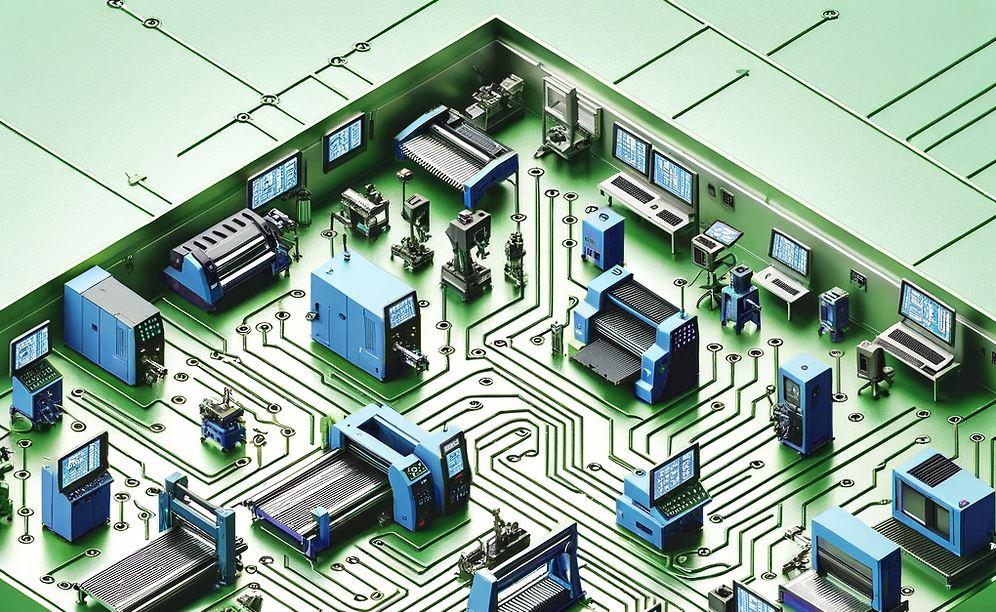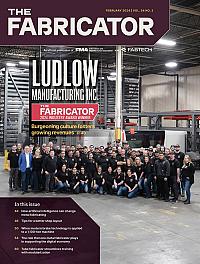CEO and Founder
- FMA
- The Fabricator
- FABTECH
- Canadian Metalworking
Categories
- Additive Manufacturing
- Aluminum Welding
- Arc Welding
- Assembly and Joining
- Automation and Robotics
- Bending and Forming
- Consumables
- Cutting and Weld Prep
- Electric Vehicles
- En Español
- Finishing
- Hydroforming
- Laser Cutting
- Laser Welding
- Machining
- Manufacturing Software
- Materials Handling
- Metals/Materials
- Oxyfuel Cutting
- Plasma Cutting
- Power Tools
- Punching and Other Holemaking
- Roll Forming
- Safety
- Sawing
- Shearing
- Shop Management
- Testing and Measuring
- Tube and Pipe Fabrication
- Tube and Pipe Production
- Waterjet Cutting
Industry Directory
Webcasts
Podcasts
FAB 40
Advertise
Subscribe
Account Login
Search
What products do custom metal fabricators sell?
Products are evolving faster, and customers are evolving with them
- By Yu Sunny Han
- February 10, 2024
- Article
- Manufacturing Software

What separates a custom metal fabricator from the pack? It’s not what the shop makes; it’s how. Images: Fulcrum
One of the things that took me a long time to realize as I learned manufacturing from the outside is that your company is your product. It’s not what you make, it’s how you make it—that’s what’s valuable to your customers. Other shops buy the same materials and the same machines as you. Your product is your entire business; it’s the way you coordinate work, the way you communicate with your customer, the way you come up with how to make things. It’s how your shop floor is laid out, how you train people, and your culture.
Customers buy from you because it’s convenient. They don’t have to commit to buying their own machine or learning how to make a part. It’s valuable to them and the primary reason they pay you money to do work.
Products are evolving faster, and your customers are evolving with them. While this is good for us as a civilization, you’ll have to continue to innovate and find better ways to run your shop to survive. You need to be more flexible than previous generations of fabricators.
What Flexibility Means to Custom Fabricators
Flexibility is about being able to absorb changes quickly. The change in what your customers expect from you must match the way you work. Prototyping work requires a lot of communication with your customer’s engineers. Higher-volume work requires coordination with buyers to plan blanket order releases. And high-precision work requires meticulous recordkeeping. Each of these requires a different group of people to work differently.
The way you work has to match your processes, rules, culture, tools, and software—the systems you rely on. If your shop uses a kanban supermarket system for inventory but your customers want lot-controlled traceability, something will break.
Growing Pains
It’s not just your customers and their products changing; you’re changing too. As you grow, the cost of coordinating everyone goes up. Whether you realize it or not, every group of people has to pay a tax as the group gets larger.
When your shop was younger, you had fewer machines and routings were simpler. Adjustments were easier. You were smaller, had fewer people. Coordination was simple. Standing in one spot, you could see everything, and you talked to everyone daily.
As your headcount and number of jobs grow, the amount of coordination and communication needed increases exponentially. It’s no longer obvious what to do next or how to do it. You might not know when to purchase a material or from whom.
Organizations grow until their systems start to break down. At that point, they either adapt by changing the way they work, communicate, and coordinate, or they shrink back down to a point where things stabilize again. It feels like the monkey bars. You don’t want to let go of what worked before, but to move forward, you have to add new things you didn’t need before. If you don’t ever let go of the past, it will hold you back. You have to remove things that served you well before but are no longer relevant.
It’s just as unreasonable to have the owner of a shop inspect every job before it goes out as it is ridiculous to imagine a shop today cutting parts manually with a torch or forming metal using a bit of elbow grease and a hammer. This always feels like losing control, but it’s necessary to allow for new connections to form.

Software allows for instant communication across the shop floor, documenting changes and easing the flow of information.
You have to let go to move forward. This has always been the case, but it’s more urgent now because the world is changing faster than ever. You used to have more breathing room to respond to updates, but now you have to adapt on a whim. The good news is that there’s a tremendous reward for solving this problem. Huge growth, riches, fame, and a peaceful, happy company await you.
Meetings, Meetings, Meetings
In the 70s and 80s, computers were introduced to manufacturing. Drawings could be changed on the fly with CAD systems. Machines were programmed to make the same part over and over again perfectly, as long as it was programmed right the first time. But these systems were built long before the internet was robust. Almost all of these tools encourage meetings as the way to distribute information and make decisions.
Most shops start the day with a production meeting. They look at the schedule, talk about materials arriving, fix problems, and brainstorm solutions. After, those in attendance distribute the information to their teams. While this increases control in the short term, it adds fragility and reduces flexibility and speed. Each attendee is a silo, holding crucial information but often failing to foster connections between teams. While well intentioned, it inadvertently leads to communication gaps and missed opportunities for collaboration, putting a lot of pressure on your management to make all the decisions, big and small.
Remove the Information Bottlenecks
Disassemble the silos that exist in the way you share information. Invest in low-cost TVs around your shop to broadcast your schedule for everyone to see, updating it for everyone when it changes. Arrange your shop to increase direct communication without a supervisor, allowing more information to flow faster.
Removing silos allows employees to solve the problems they can and for managers to focus on larger issues. Removing your production manager as a bottleneck creates the opportunity for an entirely new dynamic between your team and acts as an accelerant for the development of culture.
Now, the connectivity of the internet is being added to manufacturing. You can communicate without leaving work centers. Everyone knows the schedule at any time. When material arrives, your schedule can recalculate automatically, freeing up production managers to focus on production. When materials are late, the schedule can automatically adjust.
As your shop starts to connect, the speed builds like a flywheel. More information means better scheduling. Better scheduling means fewer delays. Fewer delays mean more accurate purchasing. Better purchasing and smoother production reduce costs. Lower costs create a larger market, driving growth and profit.
No More Trapped Information
There are a ton of new AI and computational technologies that are perfectly situated to solve big hairy problems in manufacturing that aren’t possible today because shop data is inaccessible and scattered. It’s trapped and segregated in machines, disparate software, spreadsheets, and people’s heads.
If there is a broken part, right now it’s scrapped or reworked with a few notes and measurements jotted down to be reviewed later. In the future, you’ll be able to see exactly who was operating the machine the part was made on, what the machine was doing, how much electricity was flowing through the laser, and the temperature and weather during production. You’ll be able to watch a video of the part being cut, and instantly compare it to every other part like it, to see if this was an isolated incident or a problem with the design.
Currently, we use drawings, spreadsheets, and a lot of guesswork to estimate the amount of time and materials something will take to make. The real answer is embedded in your production data. Joining together machine vibration data, in-process measurements, actual scrap rates, and labor time allows your production data to start magically calculating what you should price a job and what lead time to give.
Similar to other industries, the useful bits of data in manufacturing are way more useful when put together. When you use the maps app on your phone, thousands of other phones work together to combine speed, position, and route data to predict traffic and instantly reroute you to avoid it. Similarly, knowing the combined demand for laser cutting by geography, gauge, and lead time could help you avoid buying an expensive machine at the wrong time or allow you to staff up before your lead times drag out.
As coordination work gets automated away, you get to focus on creative brainwork, figuring out better ways to organize—and better ways to improve the whole product of your business.
We Need This
Over time, through each shop I’ve worked with, I’ve discovered just how valuable the manufacturers in our country are. America’s unique blend of capitalism, freedom, entrepreneurship, and cooperation created an environment where innovation and progress are born. It’s no mistake that most new machines, new methods, and new business models are invented here.
Without the collective effort of this community, we lose an incredibly valuable part of modern human civilization. It’s more important now than ever that every manufacturer has the tools to create this connected future. Fabricators must build systems that are not only flexible but also resilient, capable of adapting to changes while maintaining the strength and precision of their craft.
Our goal should be to create a manufacturing landscape that is more connected, efficient, and innovative than ever before. In doing so, we don’t just safeguard America’s legacy of industrial leadership; we pave the way for a resurgence of manufacturing-led innovation. It’s up to us to answer this challenge with creativity, courage, and an unwavering commitment to growth.
About the Author
subscribe now

The Fabricator is North America's leading magazine for the metal forming and fabricating industry. The magazine delivers the news, technical articles, and case histories that enable fabricators to do their jobs more efficiently. The Fabricator has served the industry since 1970.
start your free subscription- Stay connected from anywhere

Easily access valuable industry resources now with full access to the digital edition of The Fabricator.

Easily access valuable industry resources now with full access to the digital edition of The Welder.

Easily access valuable industry resources now with full access to the digital edition of The Tube and Pipe Journal.
- Podcasting
- Podcast:
- The Fabricator Podcast
- Published:
- 04/16/2024
- Running Time:
- 63:29
In this episode of The Fabricator Podcast, Caleb Chamberlain, co-founder and CEO of OSH Cut, discusses his company’s...
- Trending Articles
Tips for creating sheet metal tubes with perforations

Are two heads better than one in fiber laser cutting?

Supporting the metal fabricating industry through FMA

JM Steel triples capacity for solar energy projects at Pennsylvania facility

Omco Solar opens second Alabama manufacturing facility

- Industry Events
16th Annual Safety Conference
- April 30 - May 1, 2024
- Elgin,
Pipe and Tube Conference
- May 21 - 22, 2024
- Omaha, NE
World-Class Roll Forming Workshop
- June 5 - 6, 2024
- Louisville, KY
Advanced Laser Application Workshop
- June 25 - 27, 2024
- Novi, MI


























